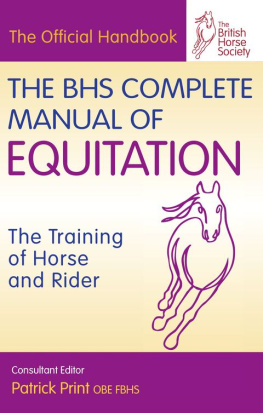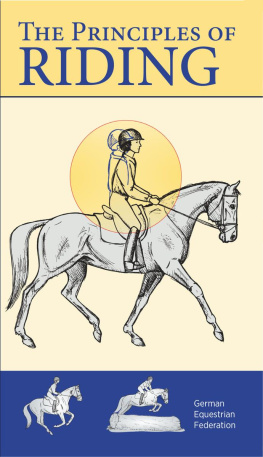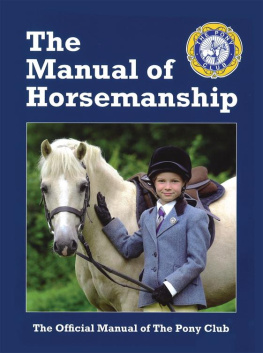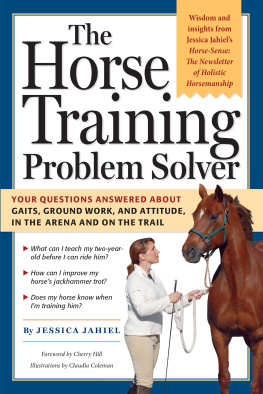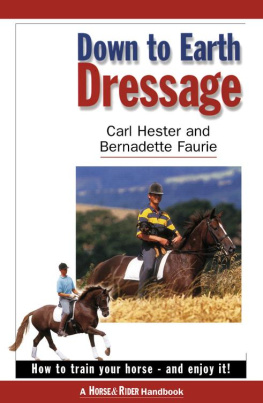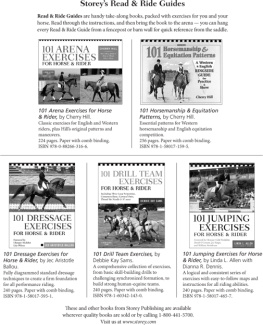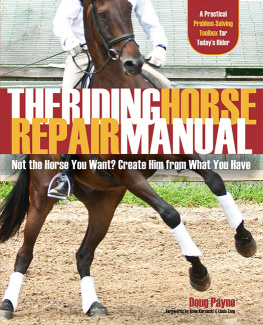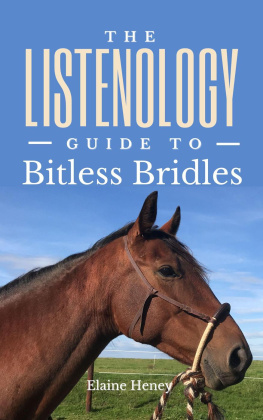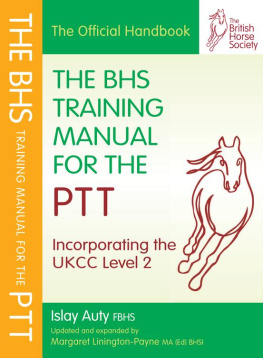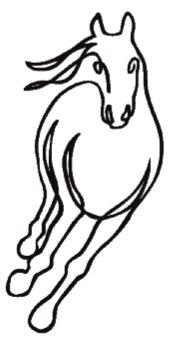THE BRITISH HORSE SOCIETYS COMPLETE MANUAL OF EQUITATION is based on the classical lines first written about by Xenophon (430354 BC ) maintained by the Spanish Riding School in Vienna and now amended for competitions by the Fdration Equestre Internationale.
Whilst it is difficult, if not impossible, to lay down hard and fast rules on the training of the horse and rider, and horsemastership in general, the Complete Manual of Equitation is a consensus of opinion of the national authorities and represents the general view in Britain of equitation and horsemastership. This book is the result of many eminent members of the British Horse Society devoting a good deal of time voluntarily to discussing and writing about the subject.
The first Manual of Equitation was edited by Jane Kidd and Barbara Slane Fleming FBHS: the second edition was revised and updated by Islay Auty FBHS. This new edition has been carefully revised and updated with contributions from the following:
Yogi Briesner FBHS a former international event rider who represented his native country of Sweden, Yogi has been based in the UK for many years and was a previous Chairman of the then BHS Training and Education Committee. Yogi is one of the worlds best-known trainers of event riders, having being GBs official team trainer for a number of years, during which time he has led GB riders to many international successes at World, Olympic and European level. He is a past recipient of The Queens Award for Equestrianism.
Carole Broad FBHS currently Chief Instructor of The Huntley School of Equitation near Gloucester, Vice Chairman of The British Horse Society, BHS Chief Assessor and Examinations Representative on the BHS Q & T Committee.
Jane Goldsmith FBHS in her youth a successful competition rider, Jane was formerly Chairman of the (then) BHS Training and Education Committee. She has served as a Trustee of the BHS and is now one of the worlds most respected trainers of para dressage riders and is one of the worlds most highly qualified para dressage judges. She was awarded the Dressage Award at the 2010 Animal Health Trust UK Equestrian Awards.
Judy Harvey FBHS an international dressage rider, trainer and judge. Judy has successfully trained many dressage and event riders to the highest level.
Sabrina Jones FBHS formerly the proprietor of Laughton Manor Equestrian Centre and currently a BHS Chief Assessor and a member of the BHS Qualifications and Training Committee, Sabrina was a successful eventer and has competed internationally at dressage.
Patrick Print FBHS Formerly BHS Scottish National Coach in the 1980s, Patrick is a freelance trainer, training many candidates for BHS exams and also competition riders. He is a BHS Chief Assessor, Member of the British Equestrian Federation Council and was Chairman of The British Horse Society from 2004 to 2010. He has previously chaired many committees, notably the BHS Training and Education Committee.
Jo Winfield FBHS a freelance trainer, BHS Chief Assessor and current Chairman of the BHS Qualification and Training Committee. Jo is also a BE accredited trainer, a BD listed dressage judge and a part-time lecturer at Hartpury College.
The book is illustrated by Dianne Breeze.
THIS BOOK IS DIVIDED INTO TWO PARTS: Training the Rider and Training the Horse. Inevitably, though, the two parts are interlinked, as it is impossible to learn to ride and progress without becoming involved in the way the horse moves, develops, improves and thinks.
Readers are therefore invited to dip into both parts of the book, referring back and forth for specific advice on training, be it for rider or horse, or both. The clear chapter headings and the comprehensive index will allow readers to move around the book easily, finding all the information they need to take their riding and the training of their horse forward to a higher level.
Riders wanting to learn more about related subjects such as saddlery, bitting and specialist care of the competition horse should refer to the companion volume The BHS Complete Manual of Horse and Stable Management which deals with these matters in some depth.
IN THE LAST 2,500 YEARS MUCH HAS BEEN WRITTEN ABOUT THE ART OF EQUITATION. Whilst there is clear evidence of riding in central Asia dating from the second millennium BC , one of the earliest and best-known treatises was written much later by the Greek general, Xenophon. His book The Art of Horsemanship was written in approximately 350 BC . Xenophon refers throughout his work to Simon of Athens and so it is very likely that the subject had been written about before. However, unlike any other narratives which may have been written two or more millennia ago, Xenophons work is the only work of such antiquity to have been preserved intact.
Many of the old classical masters refer to equitation as an art and a science. Today it is often referred to as a sport. It must be remembered, however, that (other than racing) riding as a competitive sport has only really evolved in the last 100 years or so. Before this the horse was used primarily in combat, or as a means of conveyance for hunting, or for transport, as well as a means of educating noblemen of the royal courts of Europe in the finer arts.
One trend which does appear to have emerged is that all the old masters writings were governed by the use of the horse in their period. However, what is for sure is that the horse has not changed in essence over the centuries and many of the writings and teachings of our predecessors, particularly those who advocated humane principles, still hold true today no matter what the horse is being used for.
Nowadays we have clear documentary evidence of the practice of equitation through the modern technology of film and video. Moreover, modern veterinary understanding means that our reasons for doing something are now underpinned by science. One therefore wonders whether some of the masters of yesteryear were any better than today. After all, we only have their word for it! What is clear, however, is that some of the past masters writings, when followed studiously, have time and again provided clear, humane directions for the training of the horse no matter what his use.
Some would argue that practice alone is all that is needed to progress in equitation. However any sensible horseman would advise that a sound theoretical understanding can not only enhance ones proficiency but also minimise the risk of the welfare of the horse being compromised. (And dont forget, you can practice a mistake a hundred times until you can commit that mistake perfectly)
As de la Gurinire quite rightly observed: Every science and every art has its own principles and rules that lead to new discoveries and perfection. Why should horsemanship be the only art for which practice alone is needed?
Franois Robichon de la Gurinire (16881751) was born in France and was a student of Antoine de Vendeuil. In 1731 he published his book

